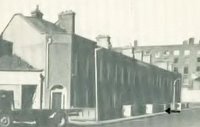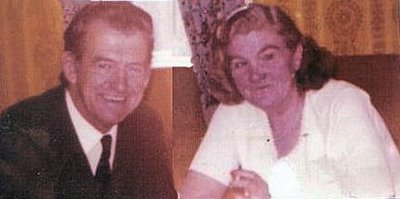
was taken sometime while we lived in The Diamond.
The reason I'm including that photo is that I've received quite a few emails asking me how old I was when I lived there.
The fact is I don't know how old I was. Maybe 3 or 4 perhaps?
You see I'm blessed, or maybe cursed with a long memory. I can remember the room we lived in on Summerhill even though I must have been only 2 or so when we moved from there to The Diamond. Though in truth I never left Summerhill behind as you'll see if you stick with me.
People have also asked me other questions and this is why I'm taking this little break from talking about the area -- I want to address at least some of those questions.
I was asked about the poverty, the size of families, the hygiene facilities, or lack of them, etc etc. I hope to address these and some questions that haven't been asked but which I think should be addressed anyway.
When I started this blog I had no idea what I was going to do with it. It was only as I was given encouragement (you know who you are) that I began to see where the Blog should go. And if you stay with me you'll see where that is.. eventually.... I hope.
On poverty. Yes, in fact I believe that most of the families that lived in our area lived in poverty. Povery of the miserably grinding kind. We lived in a country that had practically nothing. Let's take Summerhill. At one time the houses we lived in were owned and occupied by the aristocracy. Following the break up of the Act of Union of Great Britain and Ireland they left, and they sold off their properties to shylock type (in the main) landlords, who in turn allowed the buildings to fall into ruin and then rented the rooms out to poor families. Simple maintenance was never carried out while we lived there. I remember flights of stairs that didn't have banisters, or had rickety banisters. Steps missing from some of the flights of stairs. I remember people having to climb those stairs to the top of these four story buildings at night with a candle, or even a burning piece of paper used as a torch to light their way.
You see we were (and still are) a very new independent nation. At the time I was born this country was still recovering from the Easter Rebellion, which was in turn followed by the War of Independence against England. Then after we won that independence there was a bitter Civil War. This all happened in the 30 years before I was born, and it took the new nation a time to recover and to begin to prosper. Even after the English left and almost up to the time I was born they (the English) carried out a Trade War against Ireland, (No this isn't a political treatise -- just the plain truth) by placing huge tariffs on anything imported from Ireland. We made the final break from them in 1949 when we declared a Republic. Up to then we were known as The Irish Free State and had a British governer. So I suppose that makes us even younger than I said earlier.
During my childhood our biggest export was... people. There just wasn't any work here so men and women had to leave to find work wherever they could. I remember a time when my father wasn't working and he received the 'princely' sum of 10 shillings a week on the dole, and this was to feed, clothe and keep a roof over the heads of a wife and four children.
Pregnant women were given free milk, the Infant Aid Society provided that. They were also give a free meal every weekday by the nuns at The Dinner House.
Kids left school at 12, 13 and 14 to look for work or to make money in whatever way they could to help their families. It was very unusual to see a kid still at scool after the age of 14. That was the legal age at which you could end your formal education.
Death was no stranger to us even as kids. TB was rampant, the infant death rate was the second highest in the world after Calcutta in India. People died for all of the usual reasons, old age, heart attacks and so on. But they also died because they lived in rat and flea infested tenement houses, in dampness, in rooms that were cold and damp in Winter, in rooms that had a bucket in a corner covered by a curtain... the bucket being the toilet... which was emptied whenever the real toilet outside was free... and working! They slept in beds that were covered in old overcoats in an attempt to keep in some of the heat. Our rubbish was emptied into large open bins which were kept in the back yards where small kids played, and these bins were emptied once a week by the corporation cleansing department. We lived near piggeries, dirty smelly pig styes. Lanes off some of the bigger streets had people who kept pigs, goats and hens and these were allowed to roam freely. The smell is better imagined than described. Is it any wonder that all kinds of sicknesses, diseases, infections were part of everyday life? I remember when someone died in our street we (kids) used to make sure we visited the room where the body was laid out. This was because we were sure of being given a cup (sorry no glasses) of lemonade and a slice of cake for kneeling at the bed and saying a prayer for the dear departed. The adults would be sitting around drinking bottles of beer and that rare treat... a ham sandwich, just one each, and remembering the departed neighbour. Then when the body had to be moved to the local chapel the coffin was borne from the home to the chapel on the shoulders of family and neighbours -- funeral cars were too expensive and were only used to take the coffin to the actual burial.
Families were huge. It wasn't anything unusual to see families of 16 kids. In fact I knew a family who lived in a 3 room flat on Summerhill and they had 23 kids! My own mother had 6 kids who lived and I don't know how many who were still-born or miscarried. But I do know that I had two brothers and one sister who died as babies. These were Michael, Francis and Angela.
The one that I remember most was Francis (known as Fran). I loved playing with him, hearing him making his goo goo sounds and how he used to smile at me and grab my fingers tightly. Then one day he was suddenly taken away and I never saw him again. I was never told the full details, just that there was something wrong with his throat which affected his breathing. I remember one night after he died my Dad was helping me put on a jumper and I burst out crying. I thought I was never going to be able to stop, I can remember the racking sobs that I couldn't stop. My Dad held me in his arms and said gently, "Is it Fran you're crying for?" I wasn't able to answer him but he knew.
After I was dressed Dad took me for a walk. We walked around town, mostly in silence as I remember, and then as we approached our home (we lived in Gardiner Street then) my Dad pointed to a star in the night sky. He was very careful to ensure that I could actually see the star he was pointing to, and when I told him I could see it, and he was satisfied that it was the one he was pointing out, I remember his words to me. "Jimmy, that's a new star up there, that's Fran!. God needed him for a star and now he'll always be there watching over you." I felt just a little comforted, but at the same time I was thinking that I'd rather have Fran back instead of him being a star. I can still pick out that star in the night sky.
As I said at the beginning.... perhaps a long memory is more a curse tnan a blessing sometimes.
Come back soon.... I'll be moving on and promise to be more cheerful. It wasn't all doom and gloom y'know... we had great times too. Next time I think we might move into Sean McDermott Street next time and visit my Aunt Nanny and Uncle Willie... or maybe not.... is this what's called a cliffhanger?














